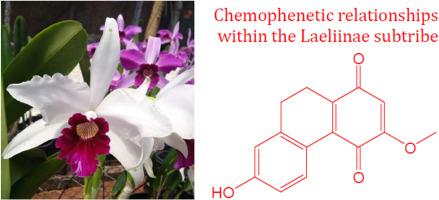紫癜的化学、化学表型和抗增殖研究
IF 2
4区 生物学
Q4 BIOCHEMISTRY & MOLECULAR BIOLOGY
引用次数: 0
摘要
本文研究了巴西著名兰科植物紫花兰(catleya purpurata)的植物化学成分、细胞毒活性和化学亲缘关系。尽管紫癜广泛种植用于观赏和商业用途,但紫癜的植物化学特征仍未得到充分研究。植物化学分析导致使用核磁共振(NMR)光谱分离和鉴定了12种化合物:三萜24-亚甲基环醇(1),甾体β-谷甾醇(2)、豆甾醇(3)和油菜甾醇(4),菲三醌类化合物phocanthone(5)和ephemeranthoquinone(8),二苯乙烯类化合物stilbostemin J(6)和3 ' - o -甲基batatasin III(10),二氢菲酮coelonin(11)和柳绿蓟素(12),酚酸类化合物水杨酸(7)和苯二酚酸(9)。利用超高效液相色谱和高分辨率飞行时间质谱(uhplc - qtof - hrms /MS)进行重复研究,可以推测鉴定出其他化合物,生物碱阿铁酰酪胺(13)、单萜内酯油橄榄内酯(14)、核苷甲基亚砜ladenosine(15)、二苯乙烯巨糖醇(16)、酚类化合物甲氧羟基酪醇(17)和丁香酸葡萄糖基酯(18)。用粗提物和馏分对人HeLa癌细胞和非肿瘤VERO细胞株进行细胞毒性试验。化学遗传学分析表明,紫癜与近缘种C. tigrina和C. intermedia亲缘关系密切,具有共同的形态和遗传特征,有利于自然杂交。这些发现强调了紫癜属植物作为一种有价值的化学遗传学研究分类单元。本文章由计算机程序翻译,如有差异,请以英文原文为准。

Chemical, chemophenetic and antiproliferative studies of Cattleya purpurata
This study investigates the phytochemical composition, cytotoxic activity, and chemophenetic relationships of Cattleya purpurata, a prominent Brazilian orchid. Despite its widespread cultivation for ornamental and commercial purposes, the phytochemical profile of C. purpurata remains underexplored. Phytochemical analysis led to the isolation and identification of 12 compounds using nuclear magnetic resonance (NMR) spectroscopy: the triterpene 24-methylenecycloartanol (1), the steroids β-sitosterol (2), stigmasterol (3), and campesterol (4), the phenanthrenequinones phocanthone (5) and ephemeranthoquinone (8), the stilbenoids stilbostemin J (6) and 3′-O-methylbatatasin III (10), the dihydrophenanthrenes coelonin (11) and lusianthridin (12), and the phenolic acids salicylic acid (7) and phloretic acid (9). Dereplication studies employing ultra-high-performance liquid chromatography coupled with high-resolution time-of-flight mass spectrometry (UHPLC-QToF-HR-MS/MS) enabled the putative identification of additional compounds, the alkaloid feruloytyramine (13), the monoterpene lactone loliolide (14), the nucleoside methylsulfinyladenosine (15), the stilbene gigantol (16), and the phenolic compounds methoxyhydroxytyrosol (17) and syringic acid glucosyl ester (18). Cytotoxicity assays were conducted on human HeLa cancer cells and non-tumor VERO cell lines using the crude extract and fractions. Chemophenetic analysis suggests a close relationship between C. purpurata and the related species C. tigrina and C. intermedia, supported by shared morphological and genetic traits that facilitate even natural hybridization. These findings underscore C. purpurata as a valuable taxon for chemophenetic studies within the Cattleya genus.
求助全文
通过发布文献求助,成功后即可免费获取论文全文。
去求助
来源期刊

Biochemical Systematics and Ecology
生物-进化生物学
CiteScore
3.00
自引率
12.50%
发文量
147
审稿时长
43 days
期刊介绍:
Biochemical Systematics and Ecology is devoted to the publication of original papers and reviews, both submitted and invited, in two subject areas: I) the application of biochemistry to problems relating to systematic biology of organisms (biochemical systematics); II) the role of biochemistry in interactions between organisms or between an organism and its environment (biochemical ecology).
In the Biochemical Systematics subject area, comparative studies of the distribution of (secondary) metabolites within a wider taxon (e.g. genus or family) are welcome. Comparative studies, encompassing multiple accessions of each of the taxa within their distribution are particularly encouraged. Welcome are also studies combining classical chemosystematic studies (such as comparative HPLC-MS or GC-MS investigations) with (macro-) molecular phylogenetic studies. Studies that involve the comparative use of compounds to help differentiate among species such as adulterants or substitutes that illustrate the applied use of chemosystematics are welcome. In contrast, studies solely employing macromolecular phylogenetic techniques (gene sequences, RAPD studies etc.) will be considered out of scope. Discouraged are manuscripts that report known or new compounds from a single source taxon without addressing a systematic hypothesis. Also considered out of scope are studies using outdated and hard to reproduce macromolecular techniques such as RAPDs in combination with standard chemosystematic techniques such as GC-FID and GC-MS.
 求助内容:
求助内容: 应助结果提醒方式:
应助结果提醒方式:


